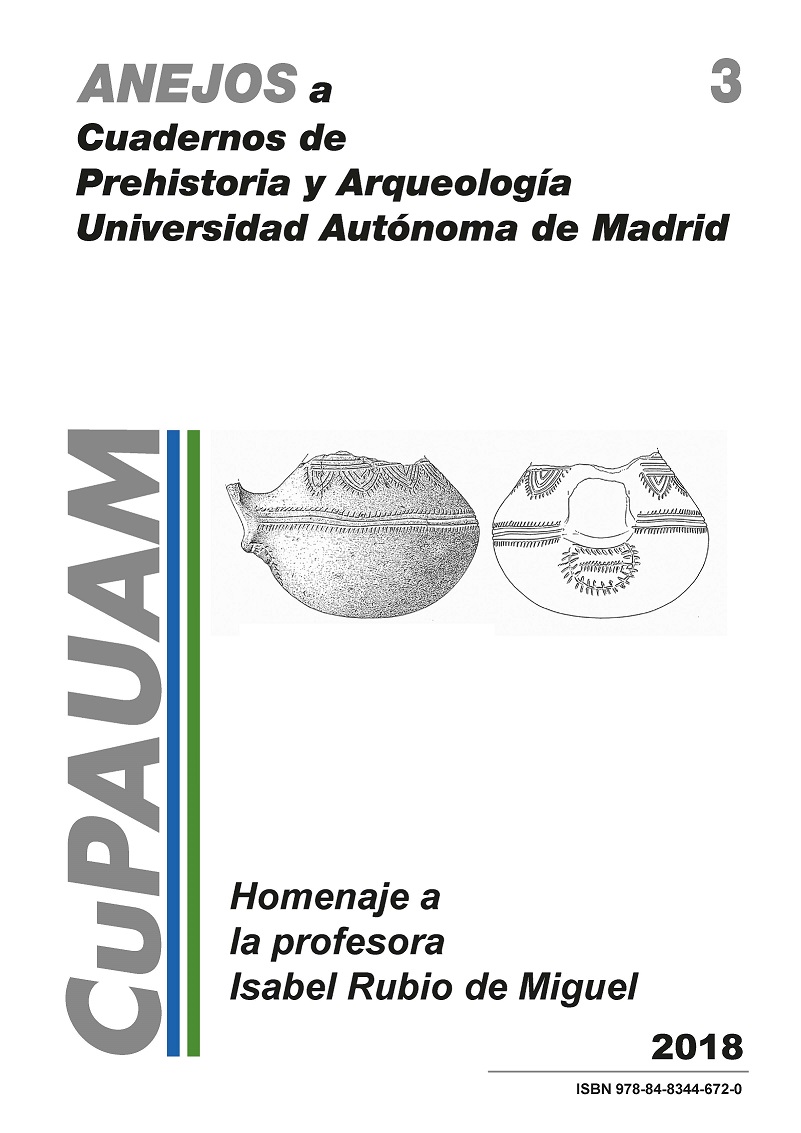The organization of apprenticeship in the Early Neolithic flint mine of Casa Montero
Keywords:
Early Neolithic, Casa Montero, flint mining, transmission of knowledge, blade productionAbstract
The Casa Montero flint mine, to date the oldest in the western Mediterranean, has provided an exceptional set of information to understand the Early Neolithic technical system of lithic production in central Iberia. The system consists of a complex network of seven harmoniously combined operating sequences. This technological knowledge was a fundamental part of the social capital of the first agrarian communities, critical for social reproduction itself and, as such, necessarily transmitted through generations. In this paper we describe the technical system, emphasizing how the on-site relationship between the production of tools and apprenticeship was organized encouraging the motivation of apprentices and avoiding competition for a paradoxically scarce high quality flint.
Downloads
References
Apel, J. (2008): “Knowledge, know-how and raw material: the production of Late Neolithic flint daggers in Scandinavia”. Journal of Archaeological Method and Theory, 15: 91-111. DOI: https://doi.org/10.1007/s10816-007-9044-2
Audouze, F. y Cattin, M. (2011): “Flint wealth versus scarcity: consequences for Magdalenian apprenticeship”. Lithic Technology, 36: 109-126. DOI: https://doi.org/10.1179/lit.2011.36.2.109
Bamforth, D.B. y Finlay, N. (2008): “Introduction. Archaeological approaches to lithic production skill and craft learning”. Journal of Archaeological Method and Theory, 15: 1-27. DOI: httpS://doi.orG/10.1007/S10816-007-9043-3
Barkai, R. y Gopher, A. (2013): “Cultural and biological transformations in the Middle Pleistocene Levant, a view from Qesem Cave, Israel”. En T. Akazawa, Y. Nishiaki y K. Aoki (eds.): Cultural perspectives. Replacement of Neanderthals by Modern Humans Series. Dynamics of learning in Neanderthals and Modern Humans 1. Tokio: 115-140. DOI: https://doi.org/10.1007/978-4-431-54511-8_7
Bustillo, M.Á.; Castañeda, N.; Capote, M.; Consuegra, S.; Criado, C.; Díaz-del-Río, P.; Orozco, T.; Pérez-Jiménez, J.L. y Terradas, X. (2009): “Is the macroscopic classification of flint useful? A petroarchaeological analysis and characterization of flint raw materials from the Iberian Neolithic mine of Casa Montero”. Archaeometry, 51 (2): 175-196. DOI: https://doi.org/10.1111/j.1475-4754.2008.00403.x
Camprubí, A.; Melgarejo, J.C.; Proenza, J.A.; Costa, F.; Bosch, J.; Estrada, A.; Borell, F.; Yushkin, N.P. y Andreichev, V.L. (2003): “Mining and geological knowledge during the Neolithic: a geological study on the variscite mines at Gavà, Catalonia”. Episodes, 26 (4): 295-301.
Capote, M. (2011): “Working in the flint mine: percussion tools and labour organization at Casa Montero (Spain)”. En M. Capote, S. Consuegra, P. Díaz-del-Río y X. Terradas (eds.): Proceedings of the 2nd international conference of the UISPP commission on flint mining in pre- and protohistoric times. (Madrid 2009). British Archaeological Reports International Series 2260. Oxford: 231-242.
Capote, M. y Díaz-del-Río, P. (2015): “Shared Labour and Large-scale Action: European Flint Mining”. En C. Fowler, J. Harding y D. Hofmann (eds.): The Oxford Handbook of Neolithic Europe. Oxford University Press. Oxford: 499-514.
Capote, M.; Castañeda, N.; Consuegra, S.; Criado C. y Díaz-del-Río, P. (2008): “Flint mining in early Neolithic Iberia: a preliminary report on Casa Montero (Madrid, Spain)”. En P. Allard, F. Bostyn, F. Giligny y J. Lech (eds.): Flint mining in prehistoric Europe: interpreting the archaeological records. British Archaeological Reports International Series 1891. Oxford: 123-137.
Castañeda, N. (2014): El trabajo del sílex: la mina del neolítico antiguo de casa Montero (Madrid) y su sistema técnico. Tesis doctoral. http://hdl.handle.net/10486/661865.
Castañeda, N. (en prensa): “Apprenticeship in early Neolithic societies. The transmission of technical knowledge at the flint mine of Casa Montero (Madrid, Spain), c. 5300-5200 cal BC”. Current Anthropology.
Castañeda, N.; Criado, C.; Nieto, A. y Casas, C. (2015): “La producción laminar de Casa Montero (Madrid)”. En V.S. Gonçalves, M. Diniz y A.C. Sousa (eds.): 5º Congresso do Neolítico peninsular. Lisboa: 480-484.
Consuegra, S. y Díaz-del-Río, P. (2017): “Early prehistoric Flint mining in Europe: a critical review of the radiocarbon evidence”. En D.H. Werra y M. Woźny (eds.): Between history and archaeology. Papers in honor of Jacek Lech. Archaeopress. Oxford: 1-8.
Consuegra, S.; Castañeda, N.; Capdevila, E.; Capote, M.; Criado, C.; Casas, C.; Nieto, A. y Díaz-del-Río, P. (2018, en prensa): “The Early Neolithic flint mine of Casa Montero (Madrid, Spain), 5350–5220 cal BC”. Trabajos de Prehistoria, 75 (1).
Díaz-del-Río, P. y Consuegra, S. (2011): “Time for action: the chronology of mining events at Casa Montero (Madrid, Spain)”. En M. Capote, S. Consuegra, P. Díaz-del-Río y X. Terradas (eds.): Proceedings of the 2nd International Conference of the UISPP Commission on Flint Mining in Pre- and Protohistoric Times. (Madrid 2009). British Archaeological Reports International Series 2260. Oxford: 221-229.
Gibaja, J.F.; Ibáñez, J.J. y González Urquijo, J. (2017): “Neolithic sickles in the Iberian Peninsula”. En A. van Gijn, J.C. Whittaker y P.C. Anderson (eds.): Explaining and exploring diversity in agricultural technology. Oxbow Books, Oxford: 112-117.
Grimm, L. (2000): “Apprentice flintknapping. Relating material culture and social practice in the Upper Palaeolithic”. En J.S. Derevensky (ed.): Children and material culture. Nueva York: 53-71.
Hovers, E. (2009): “Learning from mistakes: flaking accidents and knapping skills in the assemblage of A.L. 894 (Hadar, Ethiopia)”. En K. SChiCk y n. toth (eds.): The cutting edge: new approaches to the archaeology of human origins. Gosport: 137-150.
Lave, J. y Wenger, W. (1991): Situated learning: legitimate peripheral participation. Cambridge. DOI: https://doi.org/10.1017/CBO9780511815355
Milne, S.B. (2012): “Lithic raw material availability and Palaeo-Eskimo novice flintknapping”. En W. Wendrich (ed.): Archaeology and apprenticeship. Body knowledge, identity, and communities of practice. Tucson: 119-144.
Nishiaki, Y. (2013): “Gifting as a means of cultural transmission: The Archaeological implications of bowand-arrow technology in Papua New Guinea”. En T. Akazawa, Y. Nishiaki y K. Aoki (eds.): Cultural perspectives. Replacement of Neanderthals by Modern Humans Series. Dynamics of learning in Neanderthals and Modern Humans 1. Tokio: 173-185.
Nonaka, T.; Bril, B. y Rein, R. (2010): “How do stone knappers predict and control the outcome of flaking? Implications for understanding early stone tool technology”. Journal of Human Evolution, 59: 155-167. DOI: https://doi.org/10.1016/j.jhevol.2010.04.006
Santonja, M. y Pérez-González, A. (2010): “Mid-Pleistocene Acheulean industrial complex in the Iberian Peninsula”. Quaternary International, 223/224: 154–161. DOI: https://doi.org/10.1016/j.quaint.2010.02.010
Stout, d. (2002): “Skill and cognition in stone tool production: an ethnographic case study from Irian Jaya”. Current Anthropology, 43 (5): 693-722. DOI: httpS://doi.orG/10.1086/342638

